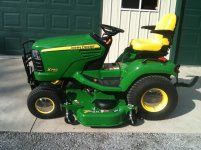The reason that mowers have stratified into two camps, the high quality but prohibitively expensive units epitomized by the 7 Series Deere, and the low cost, but not as robust mowers like the Cub Cadet, Simplicity, and various Husqvarna models is cost. Many are wishing for the good old days when mowers were built like tanks, and are perceived to last forever.
Problem is, those mowers were expensive to build, and cost a lot more in todayç—´ dollars than you think.
With a few exceptions, nobody made money selling those tanks at prices consumers would pay, so, one by one, they disappeared from the market via bankruptcy, merger, or just redefining and redesigning the product to a price point that the customers will pay.
The op has a clear choice here: belly up and pay the $7-10k that a so called å¡—igh quality mower costs, or buy the $3000 Husqvarna that fits his budget.
The Ford mower that he gets teary eyed about doesn稚 exist in the market anymore. Ford got out of that business years ago because it was a new unprofitable drag on corporate earnings.
No company can exist selling $10k mowers for $3000. International Harvester went through that in the late 1970s. The Cadet lawn and garden tractor was ranked up there with the equivalent Deere models for performance and reliability, but it was a money looser, so new lower cost, albeit not as robust, were added to the line. They sold like gang busters, but aren稚 considered as desirable today. International eventually spun off the entire lawn and garden business.
Similarly, Simplicity is now part of Briggs. The consumer voted, and low cost won.

